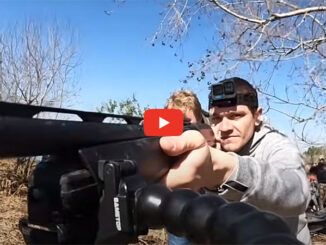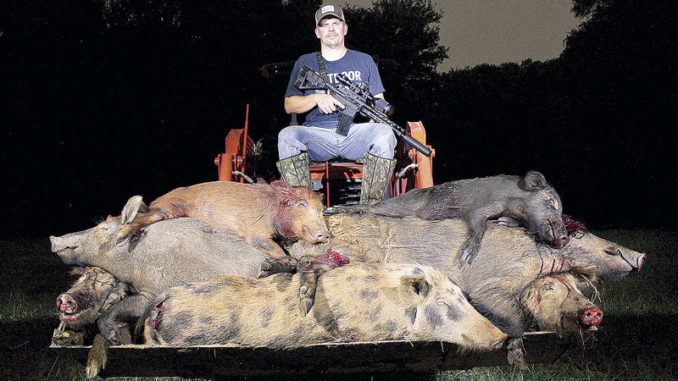
Landowners, hunting camps, farmers are all losing the battle with wild hogs across the South. Two veterans of the battle share their victories in hopes of spreading the word.
It’s man against beast, hunters vs. swine, landowners battling interlopers and native wildlife combating an invasive species.
Wild hogs have become a huge problem across much of the South. They root-up hunters’ food plots, damage farmers’ crops, tear up right-of-ways and compete with wildlife for food. The struggle is real; it’s an all-out war against the hated feral hog.
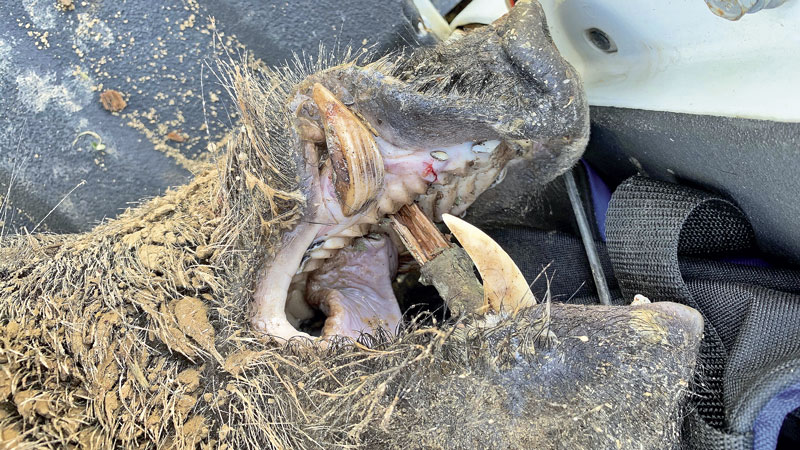
“Wild hogs are no good for the land,” said John Haralson of Bogue Chitto, an avid deer hunter and hog hunter, and a landowner who also leases hunting property. “They are fun to hunt, but there is nothing they do that is good; they have nothing positive to add.”
Landowners beware
Many people have seen or heard of the immense damage wild hogs cause row cop and cattle farmers, but they can wreak havoc on any landowner including tree farmers.
“I recently planted some hardwood on our Claiborne County land, and the hogs had a heyday with them. I had to replant 5 to 6 acres; they pulled the young saplings out of the ground and chewed their roots,” Haralson said. “I trap them and hunt them anyway I can.”
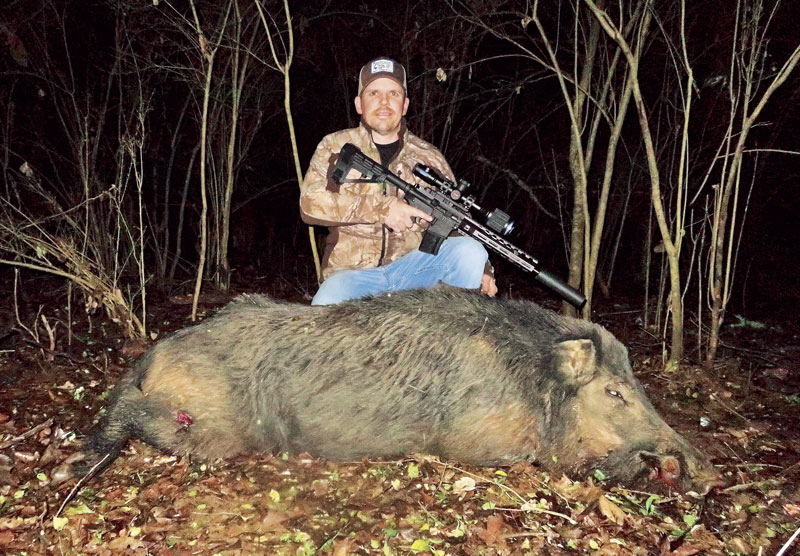
It can get worse
A look at Texas shows how bad it can be.
“I live on our 150-acre farm here in east Texas, Nacogdoches County, 30 minutes from Louisiana,” said Jason Robertson of Nacogdoches, Texas, who owns Outdoor Legacy Night Vision Optics and has been battling hogs for years. “I have improved pasture for cattle, as well as timber and log roads though the timber. I also lease adjoining acres of timber for hunting. My property is in a large creekbottom, and it is covered up with hogs. They move up and down the bottom following the creek, so there is a constant influx of new hogs all the time.
“I constantly fight hog rooting damage to my pasture; what a group of hogs or even a single large hog can do in 15 to 20 minutes can take me hours to repair with a tractor and farm implements.”
Turn on the pressure
Until the Louisiana Department of Wildlife and Fisheries can pull a rabbit out of a hat and come up with a means of controlling wild hogs, hunters and landowners will have to band together to battle these worrisome vermin.
Haralson and Roberson agree that it’s critical to keep hunting pressure on them to keep them at bay.
“They don’t like pressure. If you keep the pressure on them, they will leave for a short period of time,” Haralson said.

Hunting and shooting pressure will leave a big impact on hogs. In most cases, unless all the mature hogs are killed out of a group, shooting at them and killing one or more can have an immediate effect on them not returning to the same place for some time.
“Hogs will never be eradicated, but by keeping constant pressure on them, I can essentially run off groups of hogs that move in; they learn there are easier and safer places to live. This can last for a few days or sometimes, in a best-case scenario, up to a few weeks before more hogs move in,” Robertson said.
Live capture
Trapping is an effective way to control wild hog populations; there are many different traps and trapping philosophies. The use of traps with the remote monitoring cameras and cellular-controlled drop gates can catch an entire sounder.
“Larger, corral-type traps work well,” Haralson said, “but hogs are smart; once they have seen others trapped, they will avoid the same trap.”
Once a trap has caught a few hogs and is no longer productive, it should be moved to another area on a property.
Remember that state laws say that live hogs cannot be transported without a permit. After capture, they should be dispatched.
Let the dogs out
Hunting with dogs is another great way to put pressure on feral hogs. You may not have dogs to do this, but if you are a landowner wanting to control hogs on your property — seek help from a dog hunter.
“Dog-hunting is very effective for farmers with mature row crops and when it’s difficult to trap,” said Haralson.
The bottom line
Wild hogs have become an epidemic sweeping its way across the South. They have earned their place as the most destructive animal around. Farmers, hunters, and landowners are sick of it and have declared war.
Join the fight: hunt them during the day, hunt them at night, hunt them with dogs, call them, trap them — kill as many as you can as often as you can.
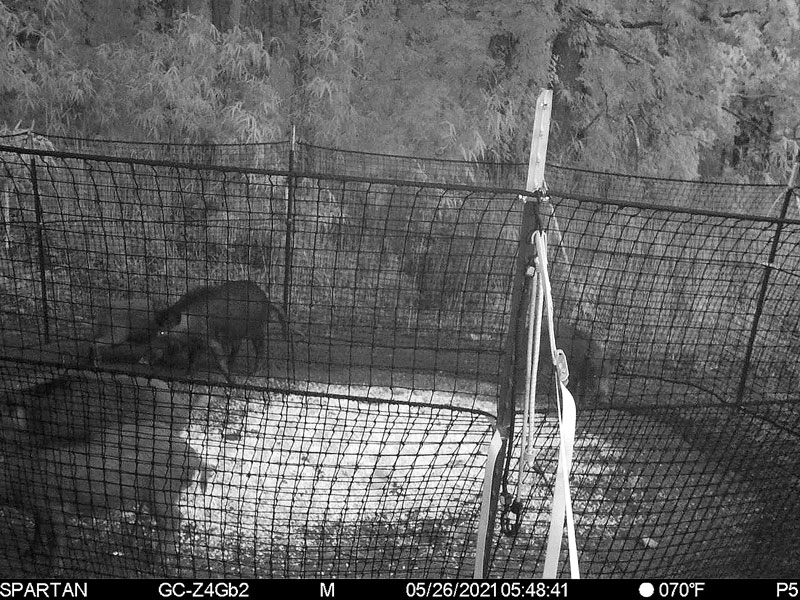
Match your hog-hunting tactics to the situation
Jason Robertson battles feral hogs year-round. The owner of Outdoor Legacy Night Vision Optics, he shares his routines for hunting hogs in hopes that it will help others find more success:
“Since I live on my own land, I hunt mostly by what I call ‘opportunity kills,’” he said. “Meaning, I scan my pasture for hogs with a thermal monocular multiple times a night between dusk and 1 a.m. If I see hogs, they are usually rooting and eating and in no rush. I can gear up and then perform a basic spot-and-stalk.
“Another method for places that I can’t easily access or see on remote properties is using cellular game cameras that send e-mails or texts when they are triggered and placing them over corn feeders, corn piles or pig pipes. This works well even when I don’t have time to go to the location and kill the hogs, because after multiple nights of getting photos, a pattern can often be established. It’s not written in stone and the pattern might not last more than a few days or a week, but it is valuable information. If I can only go one night for an hour or two, I’d rather go at a time when I know for a fact hogs have been there recently vs. picking a random time to hunt.
“Calling is another great tool that should be used when you are working off your schedule and not the hogs’. If you have limited time or just don’t want to spend hours sitting and waiting, calling is a great technique. It’s also excellent when you have smaller pastures or openings that limit how far you can see. By calling hogs, you are effectively extending the range by much further than you can see and you can also reduce the amount of time you have to sit and wait to see if hogs randomly show up in a certain place.”
The post “Time to go “whole hog” on the wild hog problem” first appeared on MS-Sportsman.com.


